Business and Business Environment: An Organizational Report
VerifiedAdded on 2023/01/05
|19
|5899
|1
Report
AI Summary
This report provides a comprehensive analysis of the business environment, encompassing various organizational types, structures, and their objectives. It explores the distinctions between public, private, and voluntary sectors, supported by real-world examples such as Tesco, the Department of Transport, and Transparent Hands. The report delves into the size and scope of different organizations, examining the interrelationships between organizational functions like finance, marketing, and production, and their impact on business operations. It further investigates the influence of both internal and external factors, including the macro environment, using the PESTLE model, and internal analysis through SWOT/TOWS analysis. The report critically evaluates the complexities of business structures and their impact on decision-making, ultimately aiming to provide a detailed understanding of how businesses operate within their environment and achieve their objectives. The report uses Tesco as a case study to understand the impact of external factors on business operations, and explores the internal strengths and weaknesses of the business and their interrelationship with the external macro factors in the environment.
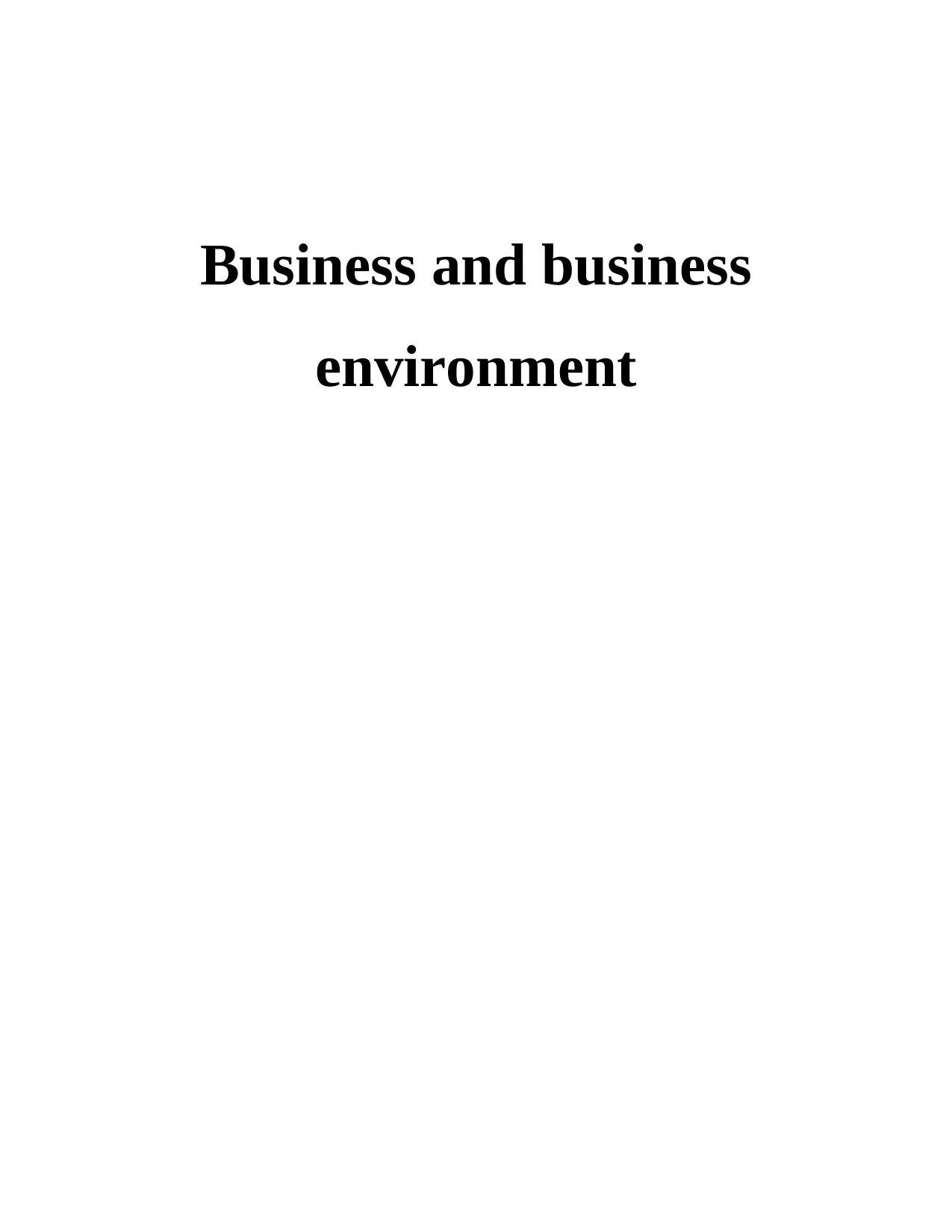
Business and business
environment
environment
Paraphrase This Document
Need a fresh take? Get an instant paraphrase of this document with our AI Paraphraser
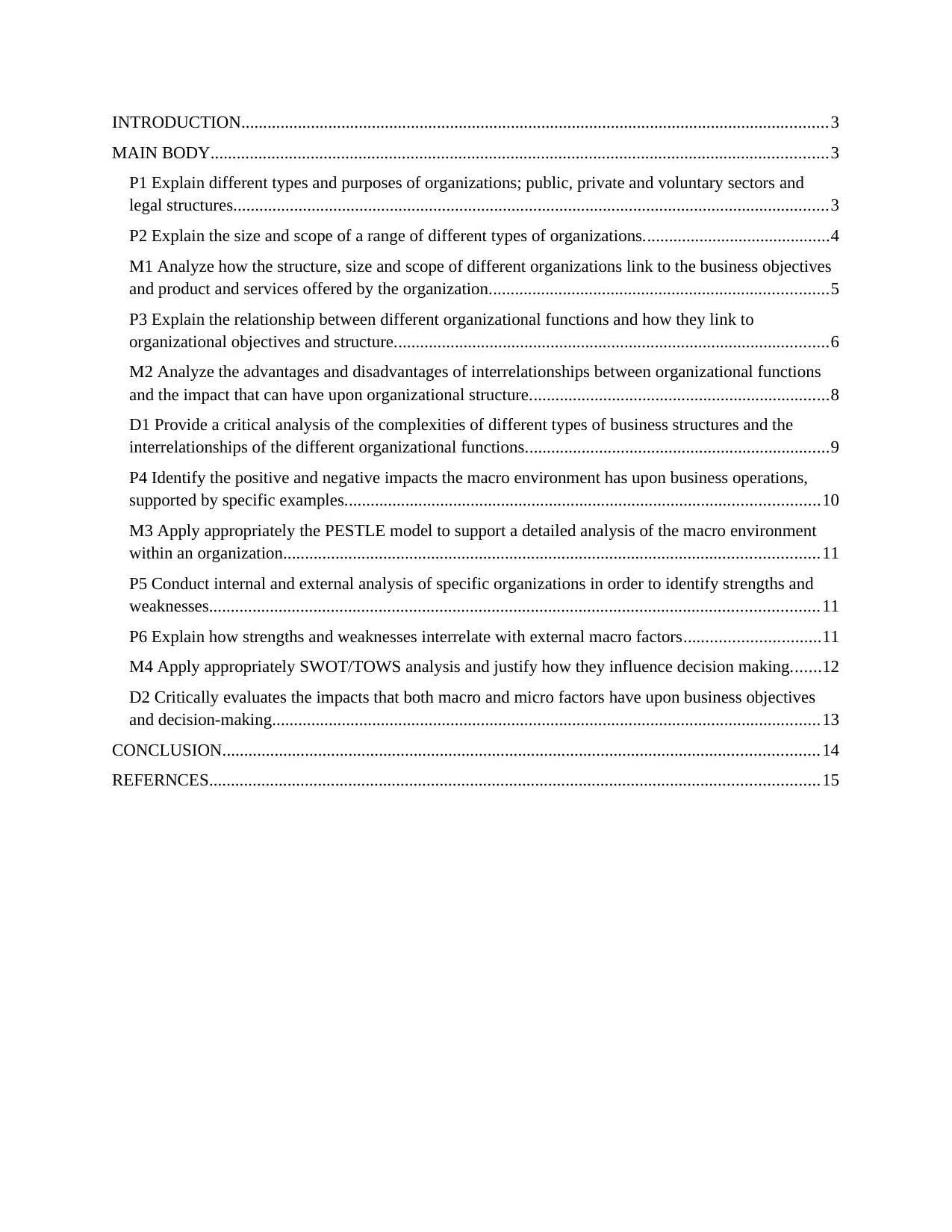
INTRODUCTION.......................................................................................................................................3
MAIN BODY..............................................................................................................................................3
P1 Explain different types and purposes of organizations; public, private and voluntary sectors and
legal structures.........................................................................................................................................3
P2 Explain the size and scope of a range of different types of organizations...........................................4
M1 Analyze how the structure, size and scope of different organizations link to the business objectives
and product and services offered by the organization..............................................................................5
P3 Explain the relationship between different organizational functions and how they link to
organizational objectives and structure....................................................................................................6
M2 Analyze the advantages and disadvantages of interrelationships between organizational functions
and the impact that can have upon organizational structure.....................................................................8
D1 Provide a critical analysis of the complexities of different types of business structures and the
interrelationships of the different organizational functions......................................................................9
P4 Identify the positive and negative impacts the macro environment has upon business operations,
supported by specific examples.............................................................................................................10
M3 Apply appropriately the PESTLE model to support a detailed analysis of the macro environment
within an organization...........................................................................................................................11
P5 Conduct internal and external analysis of specific organizations in order to identify strengths and
weaknesses............................................................................................................................................11
P6 Explain how strengths and weaknesses interrelate with external macro factors...............................11
M4 Apply appropriately SWOT/TOWS analysis and justify how they influence decision making.......12
D2 Critically evaluates the impacts that both macro and micro factors have upon business objectives
and decision-making..............................................................................................................................13
CONCLUSION.........................................................................................................................................14
REFERNCES............................................................................................................................................15
MAIN BODY..............................................................................................................................................3
P1 Explain different types and purposes of organizations; public, private and voluntary sectors and
legal structures.........................................................................................................................................3
P2 Explain the size and scope of a range of different types of organizations...........................................4
M1 Analyze how the structure, size and scope of different organizations link to the business objectives
and product and services offered by the organization..............................................................................5
P3 Explain the relationship between different organizational functions and how they link to
organizational objectives and structure....................................................................................................6
M2 Analyze the advantages and disadvantages of interrelationships between organizational functions
and the impact that can have upon organizational structure.....................................................................8
D1 Provide a critical analysis of the complexities of different types of business structures and the
interrelationships of the different organizational functions......................................................................9
P4 Identify the positive and negative impacts the macro environment has upon business operations,
supported by specific examples.............................................................................................................10
M3 Apply appropriately the PESTLE model to support a detailed analysis of the macro environment
within an organization...........................................................................................................................11
P5 Conduct internal and external analysis of specific organizations in order to identify strengths and
weaknesses............................................................................................................................................11
P6 Explain how strengths and weaknesses interrelate with external macro factors...............................11
M4 Apply appropriately SWOT/TOWS analysis and justify how they influence decision making.......12
D2 Critically evaluates the impacts that both macro and micro factors have upon business objectives
and decision-making..............................................................................................................................13
CONCLUSION.........................................................................................................................................14
REFERNCES............................................................................................................................................15
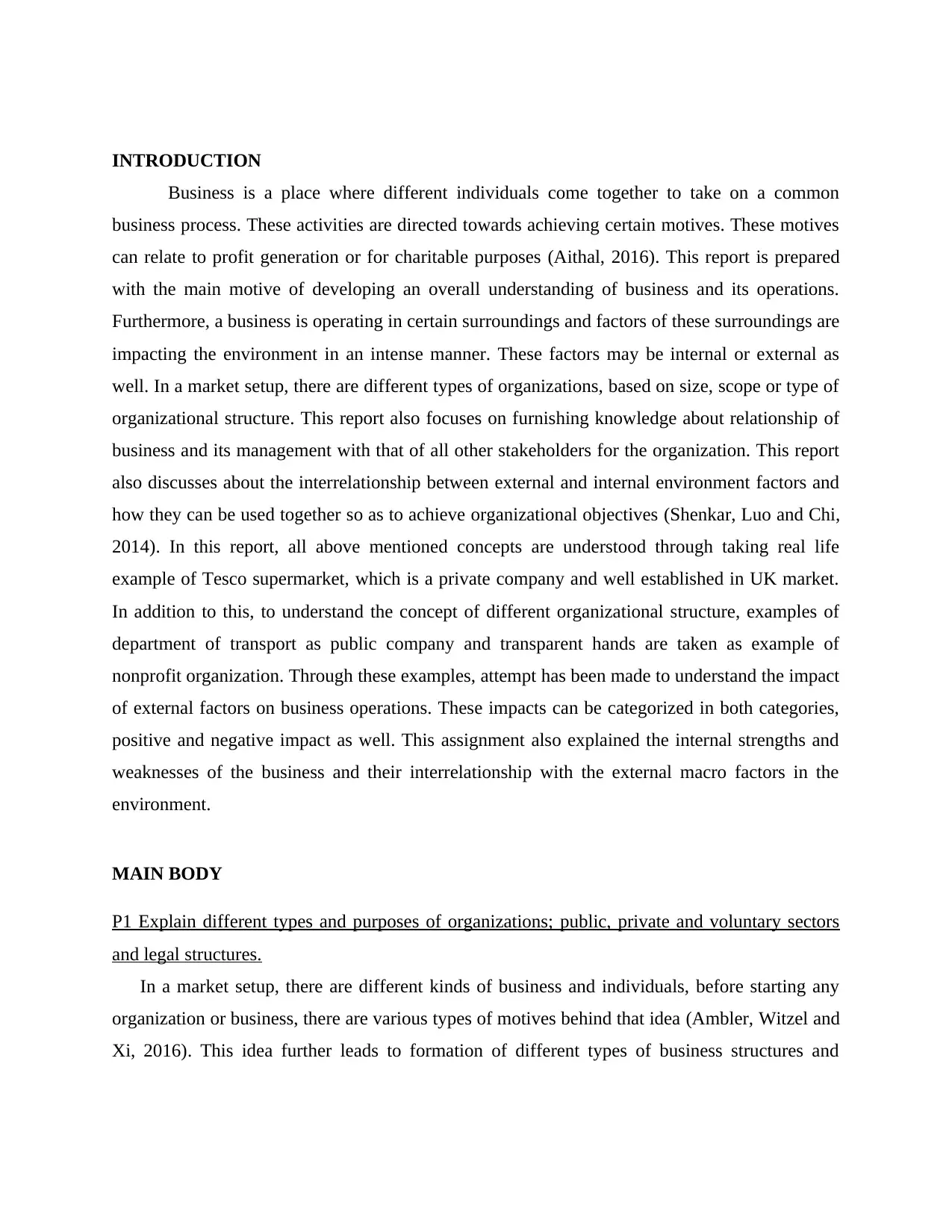
INTRODUCTION
Business is a place where different individuals come together to take on a common
business process. These activities are directed towards achieving certain motives. These motives
can relate to profit generation or for charitable purposes (Aithal, 2016). This report is prepared
with the main motive of developing an overall understanding of business and its operations.
Furthermore, a business is operating in certain surroundings and factors of these surroundings are
impacting the environment in an intense manner. These factors may be internal or external as
well. In a market setup, there are different types of organizations, based on size, scope or type of
organizational structure. This report also focuses on furnishing knowledge about relationship of
business and its management with that of all other stakeholders for the organization. This report
also discusses about the interrelationship between external and internal environment factors and
how they can be used together so as to achieve organizational objectives (Shenkar, Luo and Chi,
2014). In this report, all above mentioned concepts are understood through taking real life
example of Tesco supermarket, which is a private company and well established in UK market.
In addition to this, to understand the concept of different organizational structure, examples of
department of transport as public company and transparent hands are taken as example of
nonprofit organization. Through these examples, attempt has been made to understand the impact
of external factors on business operations. These impacts can be categorized in both categories,
positive and negative impact as well. This assignment also explained the internal strengths and
weaknesses of the business and their interrelationship with the external macro factors in the
environment.
MAIN BODY
P1 Explain different types and purposes of organizations; public, private and voluntary sectors
and legal structures.
In a market setup, there are different kinds of business and individuals, before starting any
organization or business, there are various types of motives behind that idea (Ambler, Witzel and
Xi, 2016). This idea further leads to formation of different types of business structures and
Business is a place where different individuals come together to take on a common
business process. These activities are directed towards achieving certain motives. These motives
can relate to profit generation or for charitable purposes (Aithal, 2016). This report is prepared
with the main motive of developing an overall understanding of business and its operations.
Furthermore, a business is operating in certain surroundings and factors of these surroundings are
impacting the environment in an intense manner. These factors may be internal or external as
well. In a market setup, there are different types of organizations, based on size, scope or type of
organizational structure. This report also focuses on furnishing knowledge about relationship of
business and its management with that of all other stakeholders for the organization. This report
also discusses about the interrelationship between external and internal environment factors and
how they can be used together so as to achieve organizational objectives (Shenkar, Luo and Chi,
2014). In this report, all above mentioned concepts are understood through taking real life
example of Tesco supermarket, which is a private company and well established in UK market.
In addition to this, to understand the concept of different organizational structure, examples of
department of transport as public company and transparent hands are taken as example of
nonprofit organization. Through these examples, attempt has been made to understand the impact
of external factors on business operations. These impacts can be categorized in both categories,
positive and negative impact as well. This assignment also explained the internal strengths and
weaknesses of the business and their interrelationship with the external macro factors in the
environment.
MAIN BODY
P1 Explain different types and purposes of organizations; public, private and voluntary sectors
and legal structures.
In a market setup, there are different kinds of business and individuals, before starting any
organization or business, there are various types of motives behind that idea (Ambler, Witzel and
Xi, 2016). This idea further leads to formation of different types of business structures and
⊘ This is a preview!⊘
Do you want full access?
Subscribe today to unlock all pages.

Trusted by 1+ million students worldwide
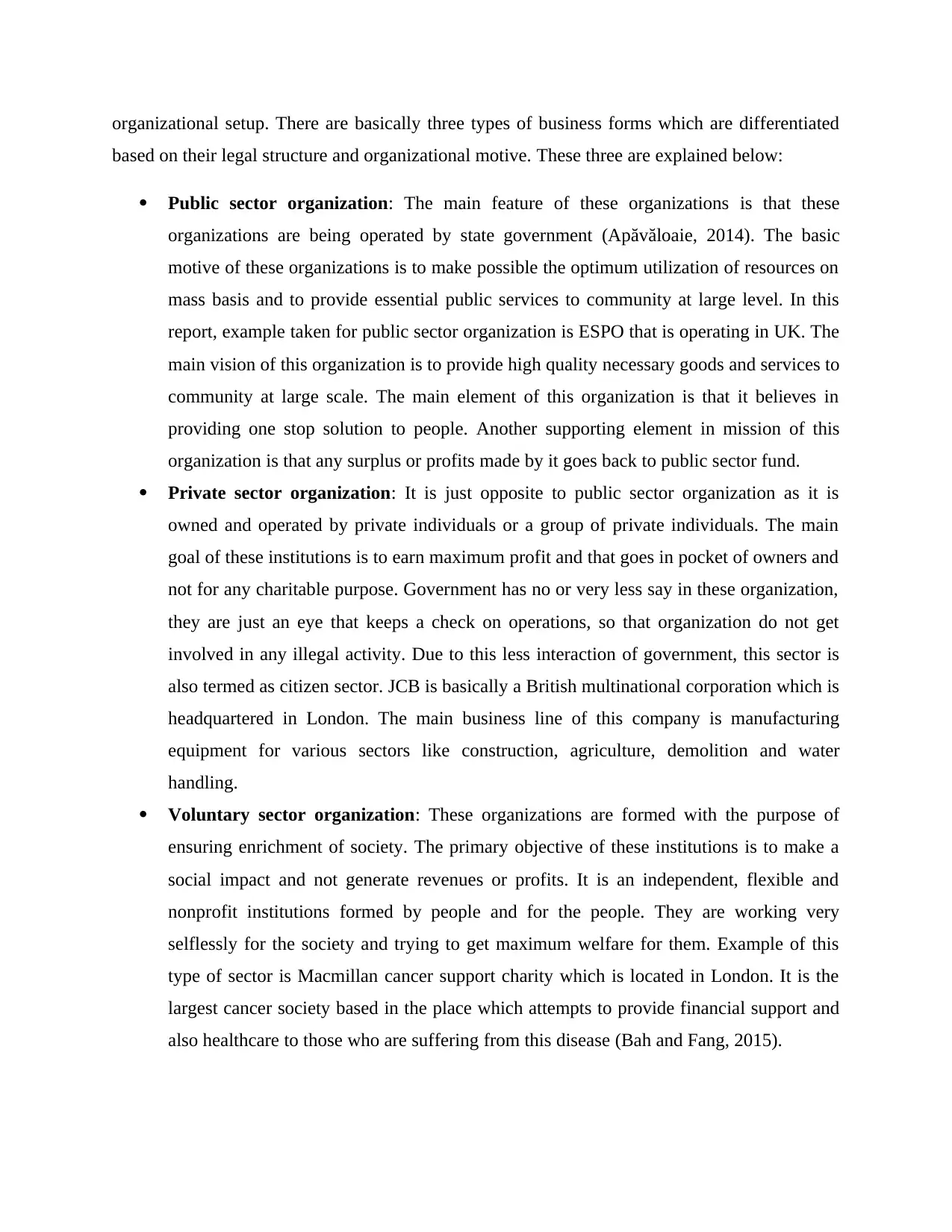
organizational setup. There are basically three types of business forms which are differentiated
based on their legal structure and organizational motive. These three are explained below:
Public sector organization: The main feature of these organizations is that these
organizations are being operated by state government (Apăvăloaie, 2014). The basic
motive of these organizations is to make possible the optimum utilization of resources on
mass basis and to provide essential public services to community at large level. In this
report, example taken for public sector organization is ESPO that is operating in UK. The
main vision of this organization is to provide high quality necessary goods and services to
community at large scale. The main element of this organization is that it believes in
providing one stop solution to people. Another supporting element in mission of this
organization is that any surplus or profits made by it goes back to public sector fund.
Private sector organization: It is just opposite to public sector organization as it is
owned and operated by private individuals or a group of private individuals. The main
goal of these institutions is to earn maximum profit and that goes in pocket of owners and
not for any charitable purpose. Government has no or very less say in these organization,
they are just an eye that keeps a check on operations, so that organization do not get
involved in any illegal activity. Due to this less interaction of government, this sector is
also termed as citizen sector. JCB is basically a British multinational corporation which is
headquartered in London. The main business line of this company is manufacturing
equipment for various sectors like construction, agriculture, demolition and water
handling.
Voluntary sector organization: These organizations are formed with the purpose of
ensuring enrichment of society. The primary objective of these institutions is to make a
social impact and not generate revenues or profits. It is an independent, flexible and
nonprofit institutions formed by people and for the people. They are working very
selflessly for the society and trying to get maximum welfare for them. Example of this
type of sector is Macmillan cancer support charity which is located in London. It is the
largest cancer society based in the place which attempts to provide financial support and
also healthcare to those who are suffering from this disease (Bah and Fang, 2015).
based on their legal structure and organizational motive. These three are explained below:
Public sector organization: The main feature of these organizations is that these
organizations are being operated by state government (Apăvăloaie, 2014). The basic
motive of these organizations is to make possible the optimum utilization of resources on
mass basis and to provide essential public services to community at large level. In this
report, example taken for public sector organization is ESPO that is operating in UK. The
main vision of this organization is to provide high quality necessary goods and services to
community at large scale. The main element of this organization is that it believes in
providing one stop solution to people. Another supporting element in mission of this
organization is that any surplus or profits made by it goes back to public sector fund.
Private sector organization: It is just opposite to public sector organization as it is
owned and operated by private individuals or a group of private individuals. The main
goal of these institutions is to earn maximum profit and that goes in pocket of owners and
not for any charitable purpose. Government has no or very less say in these organization,
they are just an eye that keeps a check on operations, so that organization do not get
involved in any illegal activity. Due to this less interaction of government, this sector is
also termed as citizen sector. JCB is basically a British multinational corporation which is
headquartered in London. The main business line of this company is manufacturing
equipment for various sectors like construction, agriculture, demolition and water
handling.
Voluntary sector organization: These organizations are formed with the purpose of
ensuring enrichment of society. The primary objective of these institutions is to make a
social impact and not generate revenues or profits. It is an independent, flexible and
nonprofit institutions formed by people and for the people. They are working very
selflessly for the society and trying to get maximum welfare for them. Example of this
type of sector is Macmillan cancer support charity which is located in London. It is the
largest cancer society based in the place which attempts to provide financial support and
also healthcare to those who are suffering from this disease (Bah and Fang, 2015).
Paraphrase This Document
Need a fresh take? Get an instant paraphrase of this document with our AI Paraphraser
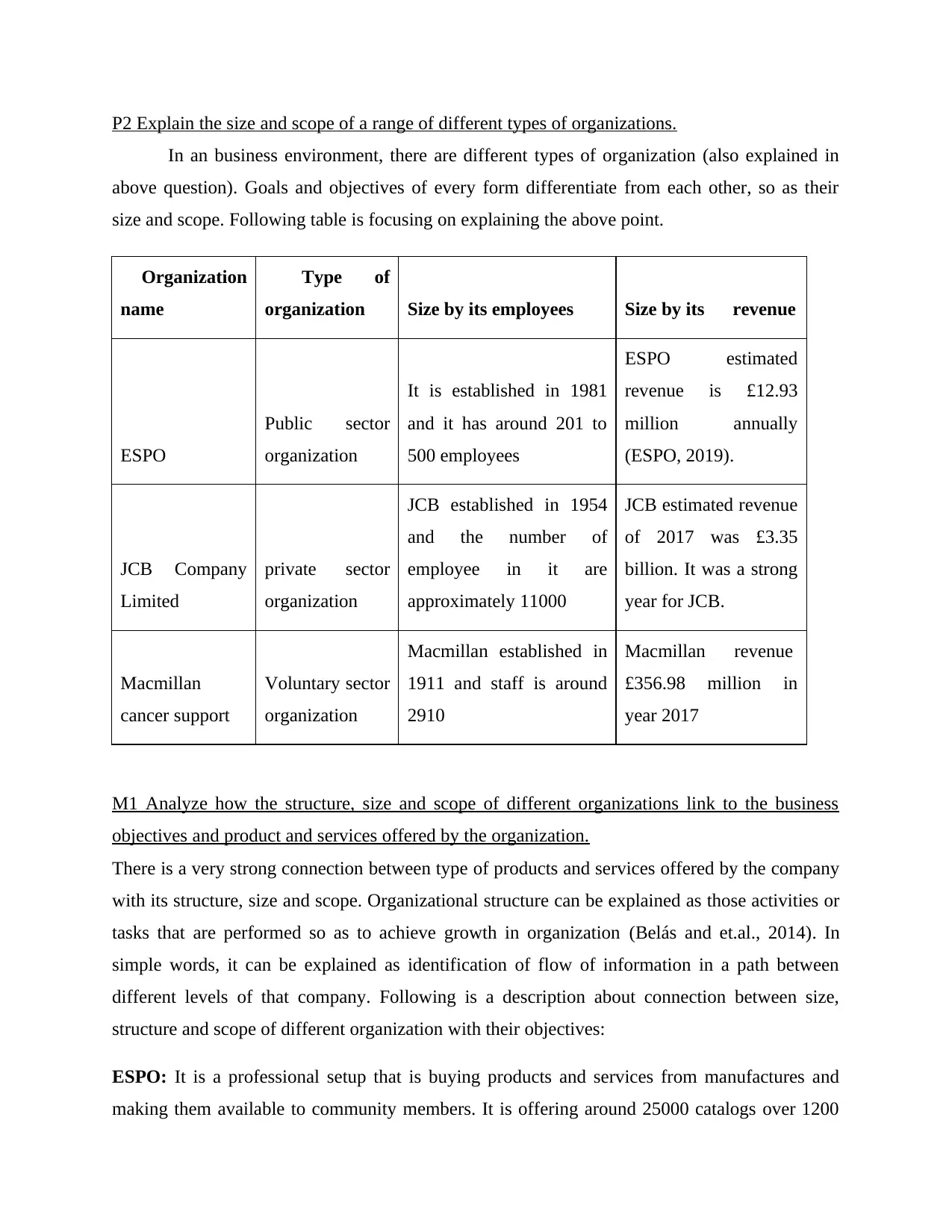
P2 Explain the size and scope of a range of different types of organizations.
In an business environment, there are different types of organization (also explained in
above question). Goals and objectives of every form differentiate from each other, so as their
size and scope. Following table is focusing on explaining the above point.
Organization
name
Type of
organization Size by its employees Size by its revenue
ESPO
Public sector
organization
It is established in 1981
and it has around 201 to
500 employees
ESPO estimated
revenue is £12.93
million annually
(ESPO, 2019).
JCB Company
Limited
private sector
organization
JCB established in 1954
and the number of
employee in it are
approximately 11000
JCB estimated revenue
of 2017 was £3.35
billion. It was a strong
year for JCB.
Macmillan
cancer support
Voluntary sector
organization
Macmillan established in
1911 and staff is around
2910
Macmillan revenue
£356.98 million in
year 2017
M1 Analyze how the structure, size and scope of different organizations link to the business
objectives and product and services offered by the organization.
There is a very strong connection between type of products and services offered by the company
with its structure, size and scope. Organizational structure can be explained as those activities or
tasks that are performed so as to achieve growth in organization (Belás and et.al., 2014). In
simple words, it can be explained as identification of flow of information in a path between
different levels of that company. Following is a description about connection between size,
structure and scope of different organization with their objectives:
ESPO: It is a professional setup that is buying products and services from manufactures and
making them available to community members. It is offering around 25000 catalogs over 1200
In an business environment, there are different types of organization (also explained in
above question). Goals and objectives of every form differentiate from each other, so as their
size and scope. Following table is focusing on explaining the above point.
Organization
name
Type of
organization Size by its employees Size by its revenue
ESPO
Public sector
organization
It is established in 1981
and it has around 201 to
500 employees
ESPO estimated
revenue is £12.93
million annually
(ESPO, 2019).
JCB Company
Limited
private sector
organization
JCB established in 1954
and the number of
employee in it are
approximately 11000
JCB estimated revenue
of 2017 was £3.35
billion. It was a strong
year for JCB.
Macmillan
cancer support
Voluntary sector
organization
Macmillan established in
1911 and staff is around
2910
Macmillan revenue
£356.98 million in
year 2017
M1 Analyze how the structure, size and scope of different organizations link to the business
objectives and product and services offered by the organization.
There is a very strong connection between type of products and services offered by the company
with its structure, size and scope. Organizational structure can be explained as those activities or
tasks that are performed so as to achieve growth in organization (Belás and et.al., 2014). In
simple words, it can be explained as identification of flow of information in a path between
different levels of that company. Following is a description about connection between size,
structure and scope of different organization with their objectives:
ESPO: It is a professional setup that is buying products and services from manufactures and
making them available to community members. It is offering around 25000 catalogs over 1200
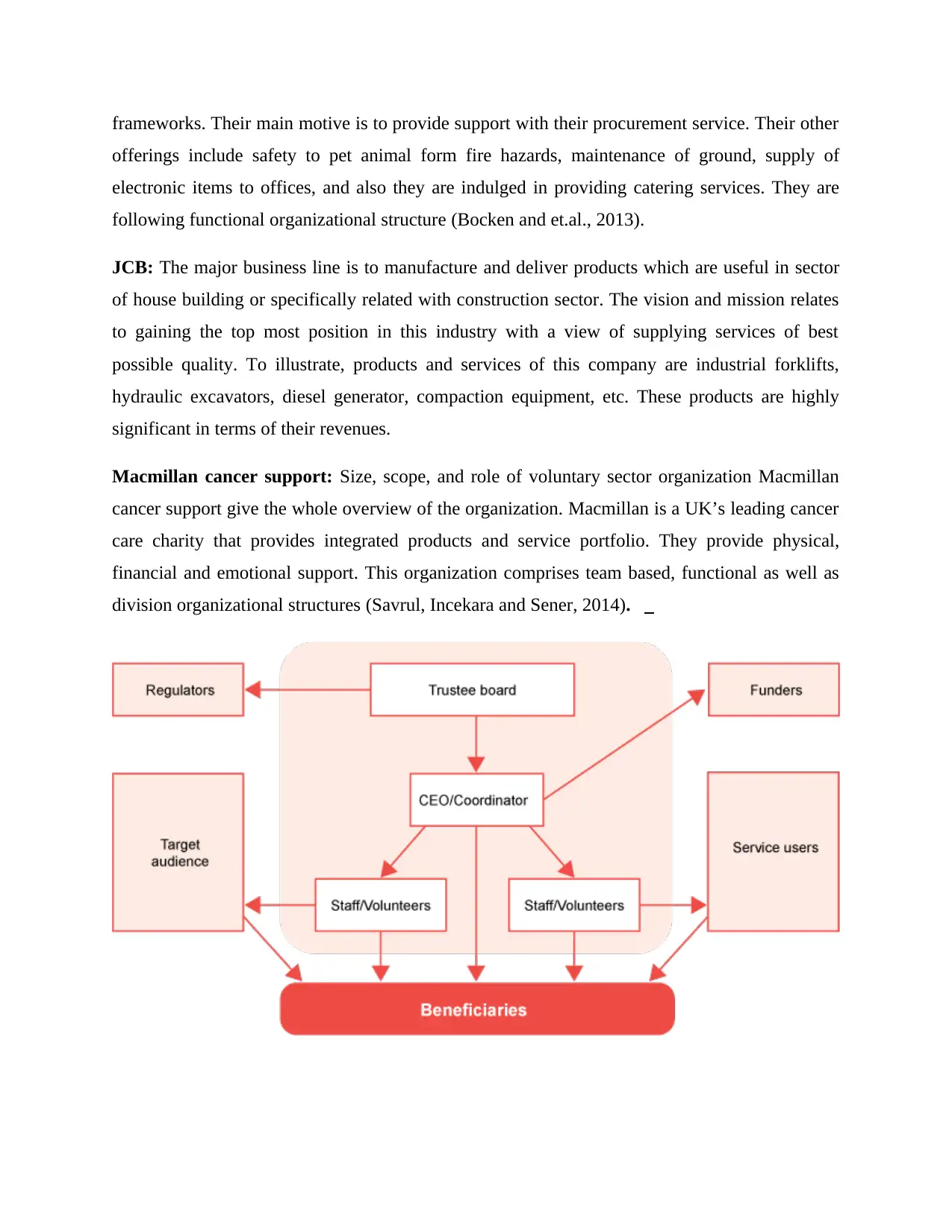
frameworks. Their main motive is to provide support with their procurement service. Their other
offerings include safety to pet animal form fire hazards, maintenance of ground, supply of
electronic items to offices, and also they are indulged in providing catering services. They are
following functional organizational structure (Bocken and et.al., 2013).
JCB: The major business line is to manufacture and deliver products which are useful in sector
of house building or specifically related with construction sector. The vision and mission relates
to gaining the top most position in this industry with a view of supplying services of best
possible quality. To illustrate, products and services of this company are industrial forklifts,
hydraulic excavators, diesel generator, compaction equipment, etc. These products are highly
significant in terms of their revenues.
Macmillan cancer support: Size, scope, and role of voluntary sector organization Macmillan
cancer support give the whole overview of the organization. Macmillan is a UK’s leading cancer
care charity that provides integrated products and service portfolio. They provide physical,
financial and emotional support. This organization comprises team based, functional as well as
division organizational structures (Savrul, Incekara and Sener, 2014).
offerings include safety to pet animal form fire hazards, maintenance of ground, supply of
electronic items to offices, and also they are indulged in providing catering services. They are
following functional organizational structure (Bocken and et.al., 2013).
JCB: The major business line is to manufacture and deliver products which are useful in sector
of house building or specifically related with construction sector. The vision and mission relates
to gaining the top most position in this industry with a view of supplying services of best
possible quality. To illustrate, products and services of this company are industrial forklifts,
hydraulic excavators, diesel generator, compaction equipment, etc. These products are highly
significant in terms of their revenues.
Macmillan cancer support: Size, scope, and role of voluntary sector organization Macmillan
cancer support give the whole overview of the organization. Macmillan is a UK’s leading cancer
care charity that provides integrated products and service portfolio. They provide physical,
financial and emotional support. This organization comprises team based, functional as well as
division organizational structures (Savrul, Incekara and Sener, 2014).
⊘ This is a preview!⊘
Do you want full access?
Subscribe today to unlock all pages.

Trusted by 1+ million students worldwide
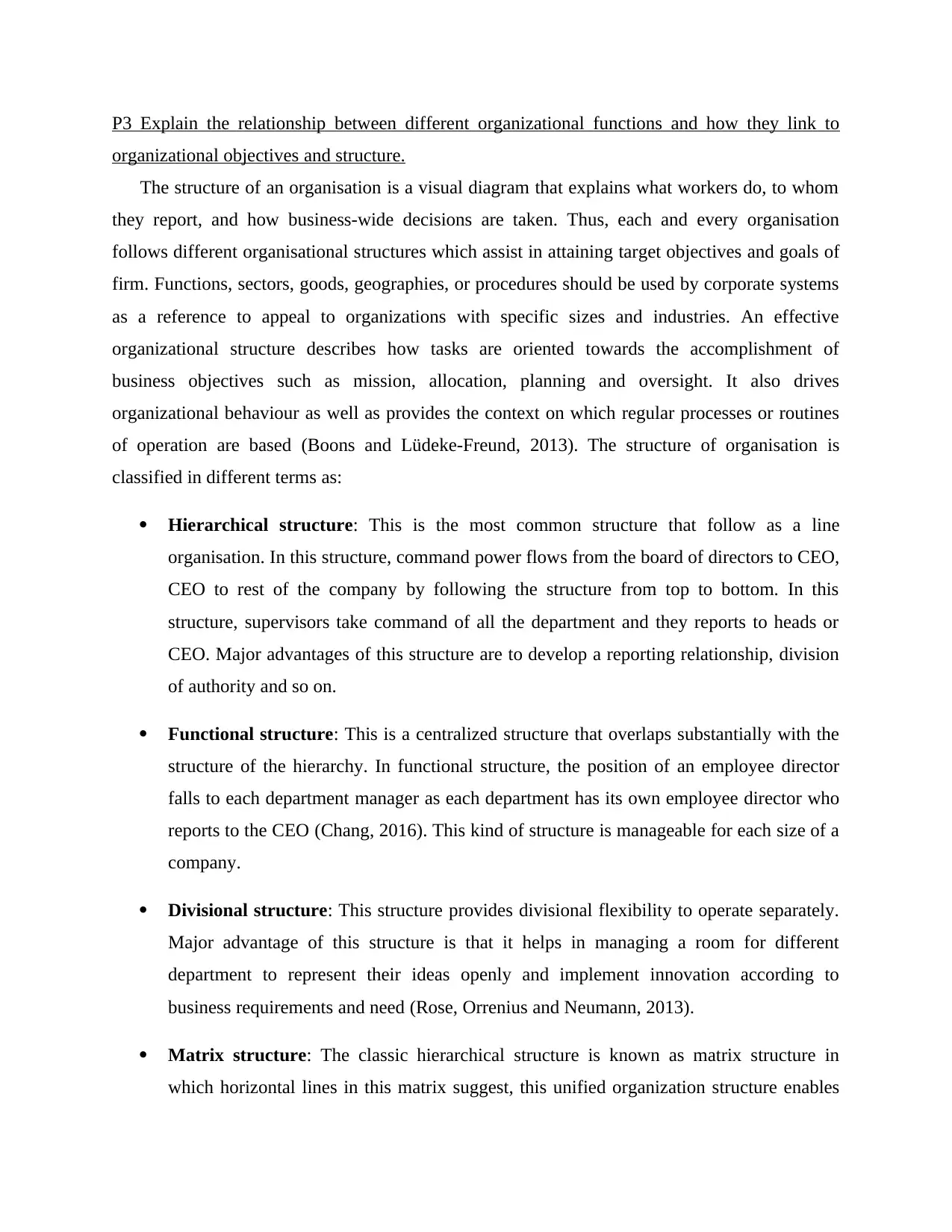
P3 Explain the relationship between different organizational functions and how they link to
organizational objectives and structure.
The structure of an organisation is a visual diagram that explains what workers do, to whom
they report, and how business-wide decisions are taken. Thus, each and every organisation
follows different organisational structures which assist in attaining target objectives and goals of
firm. Functions, sectors, goods, geographies, or procedures should be used by corporate systems
as a reference to appeal to organizations with specific sizes and industries. An effective
organizational structure describes how tasks are oriented towards the accomplishment of
business objectives such as mission, allocation, planning and oversight. It also drives
organizational behaviour as well as provides the context on which regular processes or routines
of operation are based (Boons and Lüdeke-Freund, 2013). The structure of organisation is
classified in different terms as:
Hierarchical structure: This is the most common structure that follow as a line
organisation. In this structure, command power flows from the board of directors to CEO,
CEO to rest of the company by following the structure from top to bottom. In this
structure, supervisors take command of all the department and they reports to heads or
CEO. Major advantages of this structure are to develop a reporting relationship, division
of authority and so on.
Functional structure: This is a centralized structure that overlaps substantially with the
structure of the hierarchy. In functional structure, the position of an employee director
falls to each department manager as each department has its own employee director who
reports to the CEO (Chang, 2016). This kind of structure is manageable for each size of a
company.
Divisional structure: This structure provides divisional flexibility to operate separately.
Major advantage of this structure is that it helps in managing a room for different
department to represent their ideas openly and implement innovation according to
business requirements and need (Rose, Orrenius and Neumann, 2013).
Matrix structure: The classic hierarchical structure is known as matrix structure in
which horizontal lines in this matrix suggest, this unified organization structure enables
organizational objectives and structure.
The structure of an organisation is a visual diagram that explains what workers do, to whom
they report, and how business-wide decisions are taken. Thus, each and every organisation
follows different organisational structures which assist in attaining target objectives and goals of
firm. Functions, sectors, goods, geographies, or procedures should be used by corporate systems
as a reference to appeal to organizations with specific sizes and industries. An effective
organizational structure describes how tasks are oriented towards the accomplishment of
business objectives such as mission, allocation, planning and oversight. It also drives
organizational behaviour as well as provides the context on which regular processes or routines
of operation are based (Boons and Lüdeke-Freund, 2013). The structure of organisation is
classified in different terms as:
Hierarchical structure: This is the most common structure that follow as a line
organisation. In this structure, command power flows from the board of directors to CEO,
CEO to rest of the company by following the structure from top to bottom. In this
structure, supervisors take command of all the department and they reports to heads or
CEO. Major advantages of this structure are to develop a reporting relationship, division
of authority and so on.
Functional structure: This is a centralized structure that overlaps substantially with the
structure of the hierarchy. In functional structure, the position of an employee director
falls to each department manager as each department has its own employee director who
reports to the CEO (Chang, 2016). This kind of structure is manageable for each size of a
company.
Divisional structure: This structure provides divisional flexibility to operate separately.
Major advantage of this structure is that it helps in managing a room for different
department to represent their ideas openly and implement innovation according to
business requirements and need (Rose, Orrenius and Neumann, 2013).
Matrix structure: The classic hierarchical structure is known as matrix structure in
which horizontal lines in this matrix suggest, this unified organization structure enables
Paraphrase This Document
Need a fresh take? Get an instant paraphrase of this document with our AI Paraphraser
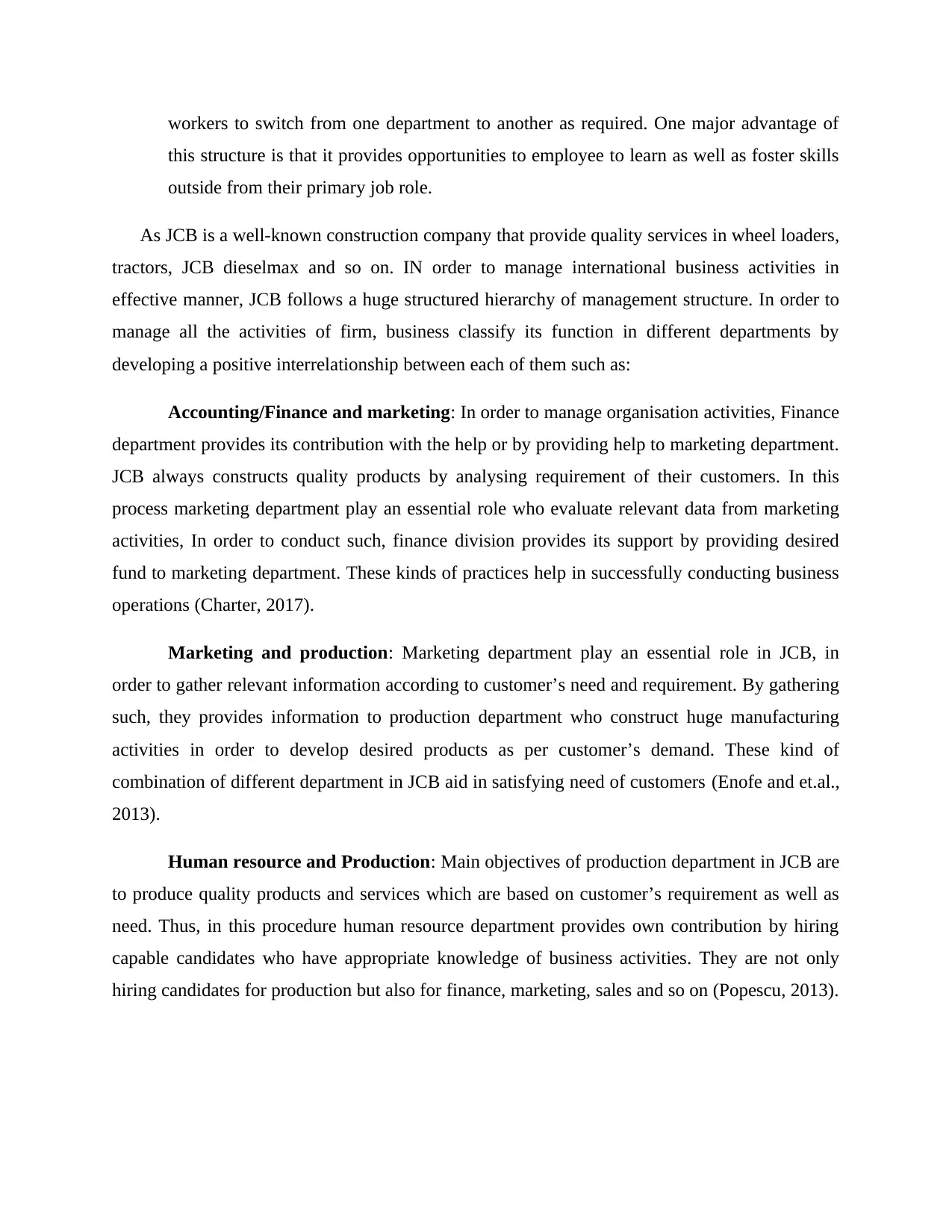
workers to switch from one department to another as required. One major advantage of
this structure is that it provides opportunities to employee to learn as well as foster skills
outside from their primary job role.
As JCB is a well-known construction company that provide quality services in wheel loaders,
tractors, JCB dieselmax and so on. IN order to manage international business activities in
effective manner, JCB follows a huge structured hierarchy of management structure. In order to
manage all the activities of firm, business classify its function in different departments by
developing a positive interrelationship between each of them such as:
Accounting/Finance and marketing: In order to manage organisation activities, Finance
department provides its contribution with the help or by providing help to marketing department.
JCB always constructs quality products by analysing requirement of their customers. In this
process marketing department play an essential role who evaluate relevant data from marketing
activities, In order to conduct such, finance division provides its support by providing desired
fund to marketing department. These kinds of practices help in successfully conducting business
operations (Charter, 2017).
Marketing and production: Marketing department play an essential role in JCB, in
order to gather relevant information according to customer’s need and requirement. By gathering
such, they provides information to production department who construct huge manufacturing
activities in order to develop desired products as per customer’s demand. These kind of
combination of different department in JCB aid in satisfying need of customers (Enofe and et.al.,
2013).
Human resource and Production: Main objectives of production department in JCB are
to produce quality products and services which are based on customer’s requirement as well as
need. Thus, in this procedure human resource department provides own contribution by hiring
capable candidates who have appropriate knowledge of business activities. They are not only
hiring candidates for production but also for finance, marketing, sales and so on (Popescu, 2013).
this structure is that it provides opportunities to employee to learn as well as foster skills
outside from their primary job role.
As JCB is a well-known construction company that provide quality services in wheel loaders,
tractors, JCB dieselmax and so on. IN order to manage international business activities in
effective manner, JCB follows a huge structured hierarchy of management structure. In order to
manage all the activities of firm, business classify its function in different departments by
developing a positive interrelationship between each of them such as:
Accounting/Finance and marketing: In order to manage organisation activities, Finance
department provides its contribution with the help or by providing help to marketing department.
JCB always constructs quality products by analysing requirement of their customers. In this
process marketing department play an essential role who evaluate relevant data from marketing
activities, In order to conduct such, finance division provides its support by providing desired
fund to marketing department. These kinds of practices help in successfully conducting business
operations (Charter, 2017).
Marketing and production: Marketing department play an essential role in JCB, in
order to gather relevant information according to customer’s need and requirement. By gathering
such, they provides information to production department who construct huge manufacturing
activities in order to develop desired products as per customer’s demand. These kind of
combination of different department in JCB aid in satisfying need of customers (Enofe and et.al.,
2013).
Human resource and Production: Main objectives of production department in JCB are
to produce quality products and services which are based on customer’s requirement as well as
need. Thus, in this procedure human resource department provides own contribution by hiring
capable candidates who have appropriate knowledge of business activities. They are not only
hiring candidates for production but also for finance, marketing, sales and so on (Popescu, 2013).
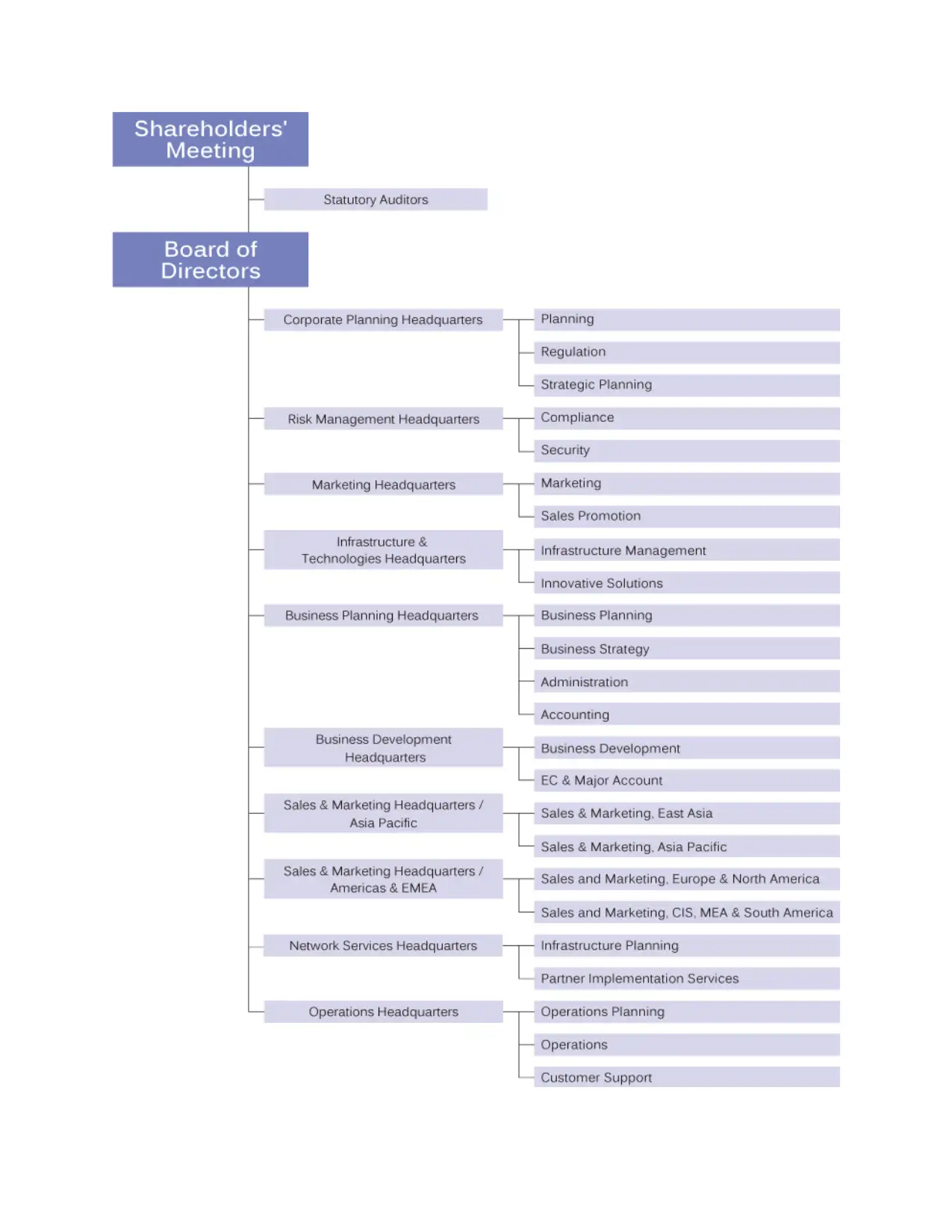
⊘ This is a preview!⊘
Do you want full access?
Subscribe today to unlock all pages.

Trusted by 1+ million students worldwide
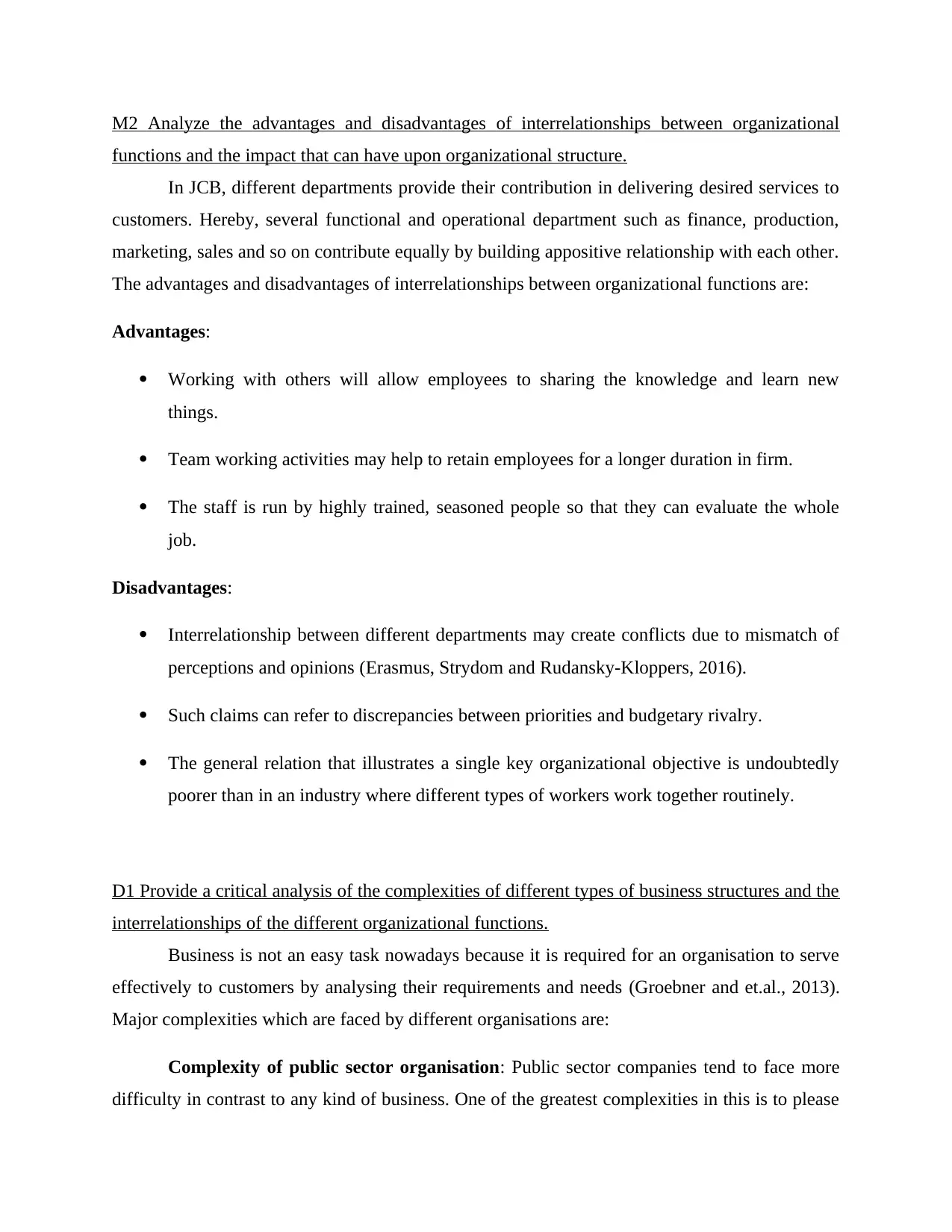
M2 Analyze the advantages and disadvantages of interrelationships between organizational
functions and the impact that can have upon organizational structure.
In JCB, different departments provide their contribution in delivering desired services to
customers. Hereby, several functional and operational department such as finance, production,
marketing, sales and so on contribute equally by building appositive relationship with each other.
The advantages and disadvantages of interrelationships between organizational functions are:
Advantages:
Working with others will allow employees to sharing the knowledge and learn new
things.
Team working activities may help to retain employees for a longer duration in firm.
The staff is run by highly trained, seasoned people so that they can evaluate the whole
job.
Disadvantages:
Interrelationship between different departments may create conflicts due to mismatch of
perceptions and opinions (Erasmus, Strydom and Rudansky-Kloppers, 2016).
Such claims can refer to discrepancies between priorities and budgetary rivalry.
The general relation that illustrates a single key organizational objective is undoubtedly
poorer than in an industry where different types of workers work together routinely.
D1 Provide a critical analysis of the complexities of different types of business structures and the
interrelationships of the different organizational functions.
Business is not an easy task nowadays because it is required for an organisation to serve
effectively to customers by analysing their requirements and needs (Groebner and et.al., 2013).
Major complexities which are faced by different organisations are:
Complexity of public sector organisation: Public sector companies tend to face more
difficulty in contrast to any kind of business. One of the greatest complexities in this is to please
functions and the impact that can have upon organizational structure.
In JCB, different departments provide their contribution in delivering desired services to
customers. Hereby, several functional and operational department such as finance, production,
marketing, sales and so on contribute equally by building appositive relationship with each other.
The advantages and disadvantages of interrelationships between organizational functions are:
Advantages:
Working with others will allow employees to sharing the knowledge and learn new
things.
Team working activities may help to retain employees for a longer duration in firm.
The staff is run by highly trained, seasoned people so that they can evaluate the whole
job.
Disadvantages:
Interrelationship between different departments may create conflicts due to mismatch of
perceptions and opinions (Erasmus, Strydom and Rudansky-Kloppers, 2016).
Such claims can refer to discrepancies between priorities and budgetary rivalry.
The general relation that illustrates a single key organizational objective is undoubtedly
poorer than in an industry where different types of workers work together routinely.
D1 Provide a critical analysis of the complexities of different types of business structures and the
interrelationships of the different organizational functions.
Business is not an easy task nowadays because it is required for an organisation to serve
effectively to customers by analysing their requirements and needs (Groebner and et.al., 2013).
Major complexities which are faced by different organisations are:
Complexity of public sector organisation: Public sector companies tend to face more
difficulty in contrast to any kind of business. One of the greatest complexities in this is to please
Paraphrase This Document
Need a fresh take? Get an instant paraphrase of this document with our AI Paraphraser

the stakeholder. These kind of issues are arise due to changing in the demand of customers on the
basis of new trends.
Complexity of private sector organisation: One major challenge which are faced by
private sector organisation to remain competitor with the help of new marketing strategies. On
the other hand, the largest complexity in such organisation is related to the administration of
finance. Furthermore, the government has implemented too many private sector laws and
regulations that are impossible to obey.
Complexity of Voluntary sector organisation: These kinds of organisations are
basically established for social purpose thus in such major complexity is belongs to internal
control. On the other hand, this organisation requires managing all the risk on timely basis by
managing all the documentation appropriately. Furthermore, the success of this organisation is
based on trustee who needs to be good to manage all the administrative activities (Gupta, 2013).
P4 Identify the positive and negative impacts the macro environment has upon business
operations, supported by specific examples.
The macro environment has impact on the business operations and functions which helps the
Tesco in identifying and evaluating positive and negative impact on activities.
In context of the macro environment the first and the for most this is to consider the
demographic factors which are important for the business are effect the business
operations to great extent. The developed countries have good conditions in terms of
financial situation which selling goods and services become easy as people there have
high income and high living standards. The company get good market conditions and
able to earn high profits in comparisonto developing countries. The economic conditions
helps in the business in identifying the various environmental factors which effect the
business activities and operations. Majorly two factors effect the business in context of
economic conditions that are demand and supply in the market place. The high demand in
the market place helps the company in making huge profits where as situation of
depression in the market lead to low demand and hence company would not be able to
make high profits.
The environmental or natural forces have the great impact on the business either in
positive or negative way. In context of the Tesco they are dealing in supermarket so they
are effected by the changes in the nature as they provide the products which are made
basis of new trends.
Complexity of private sector organisation: One major challenge which are faced by
private sector organisation to remain competitor with the help of new marketing strategies. On
the other hand, the largest complexity in such organisation is related to the administration of
finance. Furthermore, the government has implemented too many private sector laws and
regulations that are impossible to obey.
Complexity of Voluntary sector organisation: These kinds of organisations are
basically established for social purpose thus in such major complexity is belongs to internal
control. On the other hand, this organisation requires managing all the risk on timely basis by
managing all the documentation appropriately. Furthermore, the success of this organisation is
based on trustee who needs to be good to manage all the administrative activities (Gupta, 2013).
P4 Identify the positive and negative impacts the macro environment has upon business
operations, supported by specific examples.
The macro environment has impact on the business operations and functions which helps the
Tesco in identifying and evaluating positive and negative impact on activities.
In context of the macro environment the first and the for most this is to consider the
demographic factors which are important for the business are effect the business
operations to great extent. The developed countries have good conditions in terms of
financial situation which selling goods and services become easy as people there have
high income and high living standards. The company get good market conditions and
able to earn high profits in comparisonto developing countries. The economic conditions
helps in the business in identifying the various environmental factors which effect the
business activities and operations. Majorly two factors effect the business in context of
economic conditions that are demand and supply in the market place. The high demand in
the market place helps the company in making huge profits where as situation of
depression in the market lead to low demand and hence company would not be able to
make high profits.
The environmental or natural forces have the great impact on the business either in
positive or negative way. In context of the Tesco they are dealing in supermarket so they
are effected by the changes in the nature as they provide the products which are made
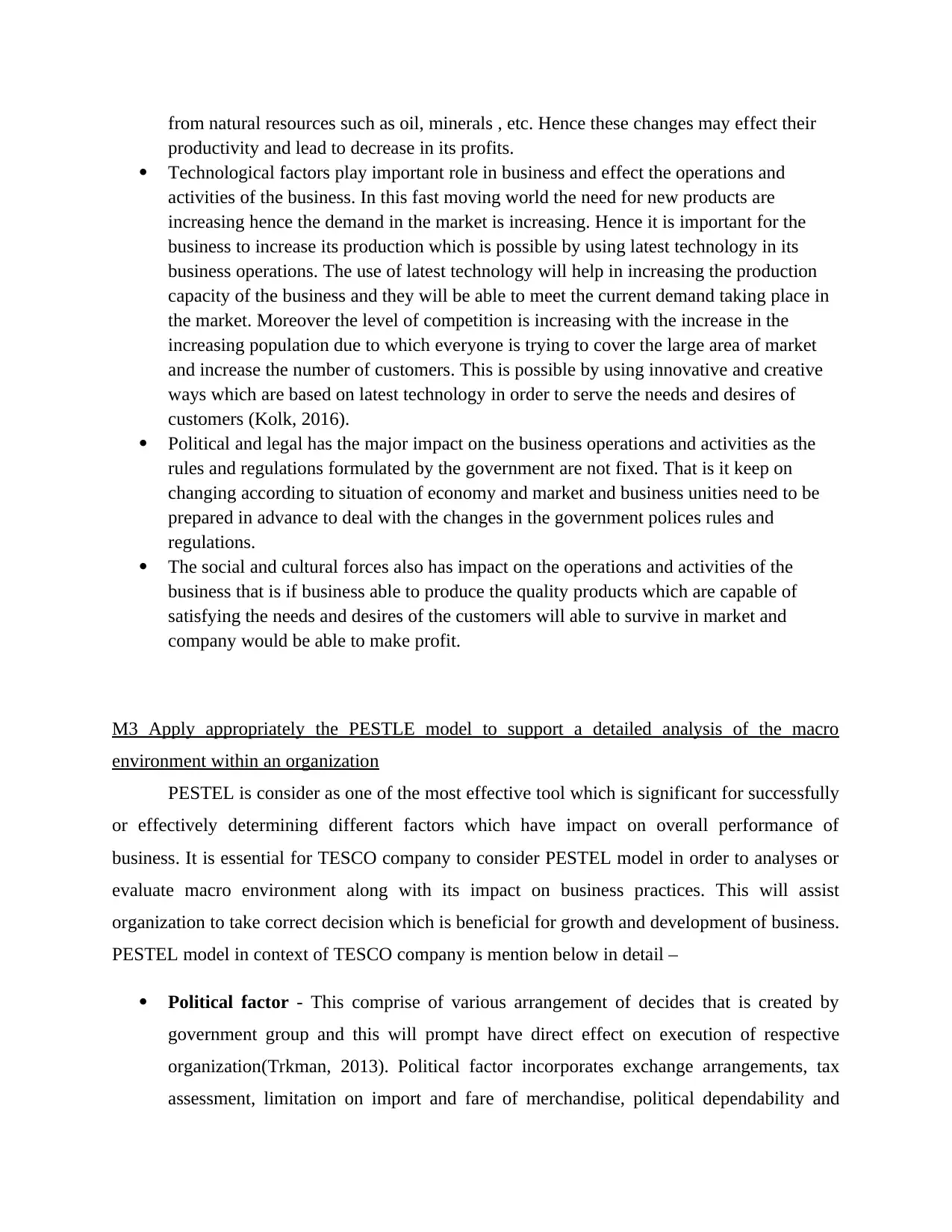
from natural resources such as oil, minerals , etc. Hence these changes may effect their
productivity and lead to decrease in its profits.
Technological factors play important role in business and effect the operations and
activities of the business. In this fast moving world the need for new products are
increasing hence the demand in the market is increasing. Hence it is important for the
business to increase its production which is possible by using latest technology in its
business operations. The use of latest technology will help in increasing the production
capacity of the business and they will be able to meet the current demand taking place in
the market. Moreover the level of competition is increasing with the increase in the
increasing population due to which everyone is trying to cover the large area of market
and increase the number of customers. This is possible by using innovative and creative
ways which are based on latest technology in order to serve the needs and desires of
customers (Kolk, 2016).
Political and legal has the major impact on the business operations and activities as the
rules and regulations formulated by the government are not fixed. That is it keep on
changing according to situation of economy and market and business unities need to be
prepared in advance to deal with the changes in the government polices rules and
regulations.
The social and cultural forces also has impact on the operations and activities of the
business that is if business able to produce the quality products which are capable of
satisfying the needs and desires of the customers will able to survive in market and
company would be able to make profit.
M3 Apply appropriately the PESTLE model to support a detailed analysis of the macro
environment within an organization
PESTEL is consider as one of the most effective tool which is significant for successfully
or effectively determining different factors which have impact on overall performance of
business. It is essential for TESCO company to consider PESTEL model in order to analyses or
evaluate macro environment along with its impact on business practices. This will assist
organization to take correct decision which is beneficial for growth and development of business.
PESTEL model in context of TESCO company is mention below in detail –
Political factor - This comprise of various arrangement of decides that is created by
government group and this will prompt have direct effect on execution of respective
organization(Trkman, 2013). Political factor incorporates exchange arrangements, tax
assessment, limitation on import and fare of merchandise, political dependability and
productivity and lead to decrease in its profits.
Technological factors play important role in business and effect the operations and
activities of the business. In this fast moving world the need for new products are
increasing hence the demand in the market is increasing. Hence it is important for the
business to increase its production which is possible by using latest technology in its
business operations. The use of latest technology will help in increasing the production
capacity of the business and they will be able to meet the current demand taking place in
the market. Moreover the level of competition is increasing with the increase in the
increasing population due to which everyone is trying to cover the large area of market
and increase the number of customers. This is possible by using innovative and creative
ways which are based on latest technology in order to serve the needs and desires of
customers (Kolk, 2016).
Political and legal has the major impact on the business operations and activities as the
rules and regulations formulated by the government are not fixed. That is it keep on
changing according to situation of economy and market and business unities need to be
prepared in advance to deal with the changes in the government polices rules and
regulations.
The social and cultural forces also has impact on the operations and activities of the
business that is if business able to produce the quality products which are capable of
satisfying the needs and desires of the customers will able to survive in market and
company would be able to make profit.
M3 Apply appropriately the PESTLE model to support a detailed analysis of the macro
environment within an organization
PESTEL is consider as one of the most effective tool which is significant for successfully
or effectively determining different factors which have impact on overall performance of
business. It is essential for TESCO company to consider PESTEL model in order to analyses or
evaluate macro environment along with its impact on business practices. This will assist
organization to take correct decision which is beneficial for growth and development of business.
PESTEL model in context of TESCO company is mention below in detail –
Political factor - This comprise of various arrangement of decides that is created by
government group and this will prompt have direct effect on execution of respective
organization(Trkman, 2013). Political factor incorporates exchange arrangements, tax
assessment, limitation on import and fare of merchandise, political dependability and
⊘ This is a preview!⊘
Do you want full access?
Subscribe today to unlock all pages.

Trusted by 1+ million students worldwide
1 out of 19
Related Documents
Your All-in-One AI-Powered Toolkit for Academic Success.
+13062052269
info@desklib.com
Available 24*7 on WhatsApp / Email
![[object Object]](/_next/static/media/star-bottom.7253800d.svg)
Unlock your academic potential
Copyright © 2020–2025 A2Z Services. All Rights Reserved. Developed and managed by ZUCOL.



